6 typical plots of world literature
The researchers studied the texts of more than 1,700 novels and found that all of them can be attributed to 6 plot types.
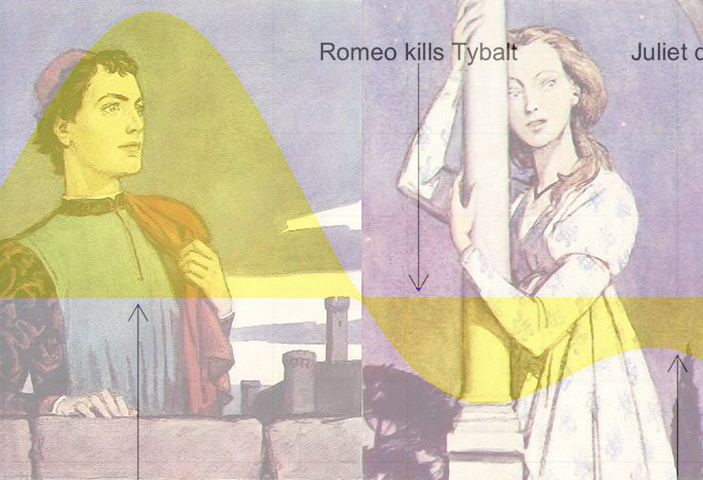
In his 1995 lecture, American novelist Kurt Vonnegut drew various plot lines on the board, illustrating the protagonist's change of position on a “good-bad” scale. Among the plots were a “cornered man”, in which the protagonist gets into trouble and eventually gets out of it, as well as the “boyfriend wins the girl”, where the hero gets something wonderful, loses it and finds it again at the end. “There are no obstacles to uploading simple forms of stories to a computer,” said Vonnegut. “These are beautiful forms.”
Thanks to new technologies of intellectual analysis, people solved this problem. Professor Matthew Jokers from the University of Washington, and later researchers from the Computer History Laboratory at the University of Vermont, analyzed the texts of thousands of novels and identified six main types of stories — archetypes — that are basic building blocks for building more complex plots. Vermont researchers have described these six forms of narration, which are the basis of the 1700 English novels, as follows:
')
1. "From rags to riches" - the gradual improvement of the situation from bad to good.
2. “Of riches in the mud” - the fall from a good position to a bad one, a tragedy.
3. "Icarus" - rise and fall.
4. “Oedipus” - fall, rise and fall again.
5. “Cinderella” - take-off, fall, take-off.
6. “Man Cornered” - Falling and Taking off.
The researchers used emotional color analysis — a statistical technique often used by marketers to evaluate social media publications. Within its framework, each word is assigned certain “tonality points” based on crowdsourced data. Depending on the vocabulary chosen, the word falls into the category of positive (“happiness”) or negative (“sadness”), or it can be associated with one of eight not so unequivocal emotions, for example, fear, joy, surprise or premonition.
For example, the adjective “happy” has a positive coloring and is associated with joy, trust and premonition, and the verb “eradicate” has a negative coloring and is associated with anger.
Apply emotional analysis to all the words in a novel, poem or play, display the results on a timeline, and you can follow the mood changes along the text in the form of a certain line - the tone of the narration.
Despite the imperfection of this approach, considering each word separately from the context, it allows to get surprisingly interesting results when analyzing large volumes of text. A good example can be found in the blog post of a computer scientist who applied computer analysis to the novels of Jane Austen.
Tools for analyzing emotional coloring are freely available, and free literary publications can be downloaded from the Project Gutenberg online repository. Below is an analysis of some beloved readers of works from the BBC survey “ 100 stories that have shaped our world, ” in which the authors attempted to discover the six plot types described above.
Type of story: "from rags to riches"
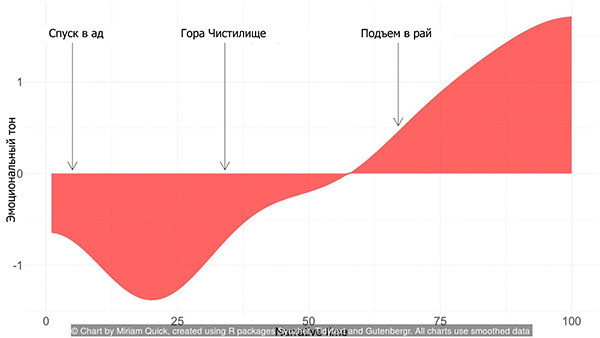
The graph is built by Miriam Quick with the R language and Syuzhet, Tidytext and Gutenbergr packages. The data on all graphs are smoothed.
Dante's structured and symmetrical epic poem shows his imaginary journey to hell in company, who do you think, whom? Of course, the poet Virgil. The negative tonality of the work is exacerbated as the duo goes through one circle of hell after another. In this situation there is some similarity with the type of plot “Man Cornered”.
Having survived hell, the heroes climb the mountain of Purgatory, inhabited by excommunicated, lustful and lazy souls. Beatrice, the deceased beloved Dante, replaces Virgil and becomes Dante's companion. The couple’s ascent to paradise in the third part of the work is marked by increasing joy, connected with the fact that the poet begins to understand the true nature of virtue, and his soul becomes one with "love moving the sun and the stars."
Type of story: "of riches in the mud"

In Flaubert’s story about a bored and unfaithful housewife, there is a moment when the heroine Emma Bovary concludes that since her life has been so bad up to this point, the rest should probably be better.
But in reality, everything turns out to be wrong. A series of unsuccessful and desperate romances awaits her, allowing her only to briefly distract herself from the tedious life of the spouse of the most boring person in the world. She accumulates huge debts and commits suicide by drinking arsenic. The grieving husband finds out about her numerous infidelities and dies later. Their orphaned daughter goes to live with her grandmother, who also soon gives her soul to the Lord. Then the girl goes to her poor aunt, who sends her to work at the spinning mill.
This is a sample of textbook tragedy, the development of which is aimed at achieving the ruthless ultimate goal of a total fall.
Type of story: "Icarus"
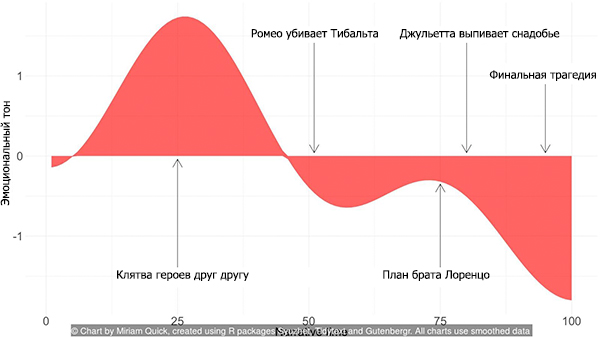
"Romeo and Juliet" is considered to be a tragedy in accordance with the description of Shakespeare himself. But an analysis of the emotional coloring of the work makes it possible to attribute it rather to the type of “Icarus” (rise and fall). After all, first a young man meets a girl and falls in love with her, and only then they are destined to lose each other. The peak of the romantic mood is about the first quarter of the length of the play - this is the famous scene under the window of Juliet, in which the characters swear to each other in love and loyalty.
From this moment begins a rapid fall. Romeo kills Tybalt and flees. Brother Lorenzo plans to help Juliet secretly escape and thus creates a false surge of hope, however, as soon as she drinks a potion, the tragic finale becomes inevitable.
Type of story: “Man Cornered” or “Cinderella”
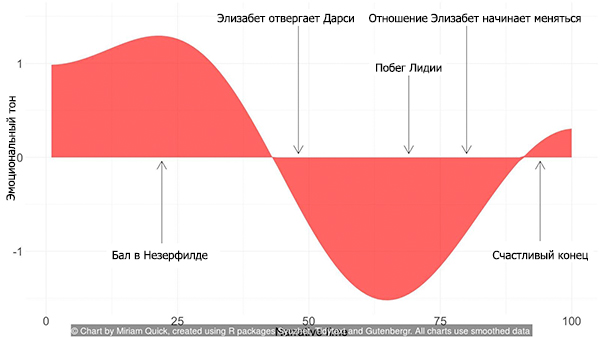
The first half of the Austin novel represents a whole series of balls, fun (albeit restrained), wit and frivolous offers of hands and hearts from the lips of heroes like the comedic vicar Mr. Collins. The situation becomes darker with the departure of Bingley, when Elizabeth has an erroneous bad impression of Darcy. The emotional background of the novel becomes clearly negative after the failure of Darcy’s marriage proposal. The peak of negative emotions falls on the escape of Lydia with the unreliable Wickham. This, of course, gives Darcy the opportunity to prove himself. And he uses it with dignity and confidence, winning the heart of Elizabeth. The narrative happily ends, and each character becomes a little wiser than he was at first.
Type of story: Oedipus
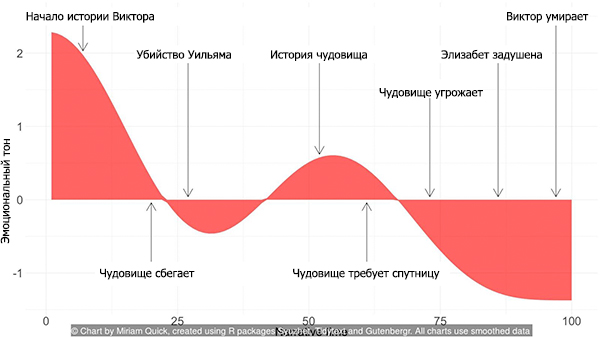
Shelley's pioneering novel is a horrific story of Victor Frankenstein’s monstrous creation, told from Victor himself by captain Walton in the form of a correspondence with his sister. At one point, the monster takes on the story, turning the novel into a bundle of stories embedded in each other. This part offers the reader a little rest from the so well begun, but constantly worsening situation. Approximately two-thirds of the novel later comes the turning point when the monster offers Victor a way out - to create a female companion for him. However, Victor refuses, and from that moment on his fate was sealed. “Remember, I will come to you on your wedding night,” the creature threatens. So it happens.
Type of story: combined

The shortest in the selected group of stories, the famous fairy tale by Hans Christian Andersen is distinguished by the most complex structure. There are two plots in it: “a man (duckling), cornered”, invested in a common, more global history like “from rags to riches”. The situation of the duckling in the course of the narrative gradually improves, but this happens not linearly, but within a series of ups and downs. At first it hatches (take-off), but is harassed due to its dissimilarity (fall). He learns that he can swim better than other ducks, and feels a sense of kinship when he sees a group of swans flying over him (take-off), but after nearly dying in cold winter (fall). In the end, the duckling turns into a swan, as expected from the very beginning. This, of course, was the essence of the story: the swan remains a swan, even if his egg was a duck on the farm. The story ends on the highest note. The mature swan happily admits that "I could not even dream of such happiness."


In his 1995 lecture, American novelist Kurt Vonnegut drew various plot lines on the board, illustrating the protagonist's change of position on a “good-bad” scale. Among the plots were a “cornered man”, in which the protagonist gets into trouble and eventually gets out of it, as well as the “boyfriend wins the girl”, where the hero gets something wonderful, loses it and finds it again at the end. “There are no obstacles to uploading simple forms of stories to a computer,” said Vonnegut. “These are beautiful forms.”
Thanks to new technologies of intellectual analysis, people solved this problem. Professor Matthew Jokers from the University of Washington, and later researchers from the Computer History Laboratory at the University of Vermont, analyzed the texts of thousands of novels and identified six main types of stories — archetypes — that are basic building blocks for building more complex plots. Vermont researchers have described these six forms of narration, which are the basis of the 1700 English novels, as follows:
')
1. "From rags to riches" - the gradual improvement of the situation from bad to good.
2. “Of riches in the mud” - the fall from a good position to a bad one, a tragedy.
3. "Icarus" - rise and fall.
4. “Oedipus” - fall, rise and fall again.
5. “Cinderella” - take-off, fall, take-off.
6. “Man Cornered” - Falling and Taking off.
The researchers used emotional color analysis — a statistical technique often used by marketers to evaluate social media publications. Within its framework, each word is assigned certain “tonality points” based on crowdsourced data. Depending on the vocabulary chosen, the word falls into the category of positive (“happiness”) or negative (“sadness”), or it can be associated with one of eight not so unequivocal emotions, for example, fear, joy, surprise or premonition.
For example, the adjective “happy” has a positive coloring and is associated with joy, trust and premonition, and the verb “eradicate” has a negative coloring and is associated with anger.
Apply emotional analysis to all the words in a novel, poem or play, display the results on a timeline, and you can follow the mood changes along the text in the form of a certain line - the tone of the narration.
Despite the imperfection of this approach, considering each word separately from the context, it allows to get surprisingly interesting results when analyzing large volumes of text. A good example can be found in the blog post of a computer scientist who applied computer analysis to the novels of Jane Austen.
Tools for analyzing emotional coloring are freely available, and free literary publications can be downloaded from the Project Gutenberg online repository. Below is an analysis of some beloved readers of works from the BBC survey “ 100 stories that have shaped our world, ” in which the authors attempted to discover the six plot types described above.
The Divine Comedy (Dante Alighieri, 1308–1320)
Type of story: "from rags to riches"

The graph is built by Miriam Quick with the R language and Syuzhet, Tidytext and Gutenbergr packages. The data on all graphs are smoothed.
Dante's structured and symmetrical epic poem shows his imaginary journey to hell in company, who do you think, whom? Of course, the poet Virgil. The negative tonality of the work is exacerbated as the duo goes through one circle of hell after another. In this situation there is some similarity with the type of plot “Man Cornered”.
Having survived hell, the heroes climb the mountain of Purgatory, inhabited by excommunicated, lustful and lazy souls. Beatrice, the deceased beloved Dante, replaces Virgil and becomes Dante's companion. The couple’s ascent to paradise in the third part of the work is marked by increasing joy, connected with the fact that the poet begins to understand the true nature of virtue, and his soul becomes one with "love moving the sun and the stars."
Madame Bovary (Gustave Flaubert, 1856)
Type of story: "of riches in the mud"

In Flaubert’s story about a bored and unfaithful housewife, there is a moment when the heroine Emma Bovary concludes that since her life has been so bad up to this point, the rest should probably be better.
But in reality, everything turns out to be wrong. A series of unsuccessful and desperate romances awaits her, allowing her only to briefly distract herself from the tedious life of the spouse of the most boring person in the world. She accumulates huge debts and commits suicide by drinking arsenic. The grieving husband finds out about her numerous infidelities and dies later. Their orphaned daughter goes to live with her grandmother, who also soon gives her soul to the Lord. Then the girl goes to her poor aunt, who sends her to work at the spinning mill.
This is a sample of textbook tragedy, the development of which is aimed at achieving the ruthless ultimate goal of a total fall.
Romeo and Juliet (William Shakespeare, 1597)
Type of story: "Icarus"

"Romeo and Juliet" is considered to be a tragedy in accordance with the description of Shakespeare himself. But an analysis of the emotional coloring of the work makes it possible to attribute it rather to the type of “Icarus” (rise and fall). After all, first a young man meets a girl and falls in love with her, and only then they are destined to lose each other. The peak of the romantic mood is about the first quarter of the length of the play - this is the famous scene under the window of Juliet, in which the characters swear to each other in love and loyalty.
From this moment begins a rapid fall. Romeo kills Tybalt and flees. Brother Lorenzo plans to help Juliet secretly escape and thus creates a false surge of hope, however, as soon as she drinks a potion, the tragic finale becomes inevitable.
"Pride and Prejudice" (Jane Austen, 1813)
Type of story: “Man Cornered” or “Cinderella”

The first half of the Austin novel represents a whole series of balls, fun (albeit restrained), wit and frivolous offers of hands and hearts from the lips of heroes like the comedic vicar Mr. Collins. The situation becomes darker with the departure of Bingley, when Elizabeth has an erroneous bad impression of Darcy. The emotional background of the novel becomes clearly negative after the failure of Darcy’s marriage proposal. The peak of negative emotions falls on the escape of Lydia with the unreliable Wickham. This, of course, gives Darcy the opportunity to prove himself. And he uses it with dignity and confidence, winning the heart of Elizabeth. The narrative happily ends, and each character becomes a little wiser than he was at first.
"Frankenstein, or Modern Prometheus" (Mary Shelley, 1818)
Type of story: Oedipus

Shelley's pioneering novel is a horrific story of Victor Frankenstein’s monstrous creation, told from Victor himself by captain Walton in the form of a correspondence with his sister. At one point, the monster takes on the story, turning the novel into a bundle of stories embedded in each other. This part offers the reader a little rest from the so well begun, but constantly worsening situation. Approximately two-thirds of the novel later comes the turning point when the monster offers Victor a way out - to create a female companion for him. However, Victor refuses, and from that moment on his fate was sealed. “Remember, I will come to you on your wedding night,” the creature threatens. So it happens.
The Ugly Duckling (Hans Christian Andersen, 1843)
Type of story: combined

The shortest in the selected group of stories, the famous fairy tale by Hans Christian Andersen is distinguished by the most complex structure. There are two plots in it: “a man (duckling), cornered”, invested in a common, more global history like “from rags to riches”. The situation of the duckling in the course of the narrative gradually improves, but this happens not linearly, but within a series of ups and downs. At first it hatches (take-off), but is harassed due to its dissimilarity (fall). He learns that he can swim better than other ducks, and feels a sense of kinship when he sees a group of swans flying over him (take-off), but after nearly dying in cold winter (fall). In the end, the duckling turns into a swan, as expected from the very beginning. This, of course, was the essence of the story: the swan remains a swan, even if his egg was a duck on the farm. The story ends on the highest note. The mature swan happily admits that "I could not even dream of such happiness."

Source: https://habr.com/ru/post/428407/
All Articles